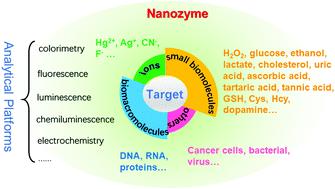当前位置:
X-MOL 学术
›
J. Mater. Chem. B
›
论文详情
Our official English website, www.x-mol.net, welcomes your
feedback! (Note: you will need to create a separate account there.)
Recent progress in the design of analytical methods based on nanozymes
Journal of Materials Chemistry B ( IF 6.1 ) Pub Date : 2021-08-18 , DOI: 10.1039/d1tb01521d Qingqing Wang 1 , Shaoqin Liu 1 , Zhiyong Tang 2
Journal of Materials Chemistry B ( IF 6.1 ) Pub Date : 2021-08-18 , DOI: 10.1039/d1tb01521d Qingqing Wang 1 , Shaoqin Liu 1 , Zhiyong Tang 2
Affiliation

|
Nanomaterials with intrinsic enzyme-like properties (nanozymes) have attracted growing interest owing to their striking merits over the traditional enzymes, such as low cost, easy surface modification, high stability and robustness, and tunable activity. These features enable them to be considered as a potent substitute for natural enzymes to construct novel analytical platforms to detect various analytes from small molecules to proteins and cells. In this review, we focus on recent advances in the design strategies using nanozyme catalytic mediated signal amplification for sensing applications. The progress of nanozyme-based analytical systems in the detection of different types of analytes, including ions, small biomolecules, biomacromolecules and others, is summarized. Furthermore, the future challenges and opportunities of nanozyme-based analytical methods are discussed.
中文翻译:

基于纳米酶的分析方法设计的最新进展
具有内在酶样特性的纳米材料(纳米酶)由于其相对于传统酶的显着优点而引起了越来越多的关注,例如低成本、易于表面修饰、高稳定性和鲁棒性以及可调节的活性。这些特性使它们能够被视为天然酶的有效替代品,以构建新的分析平台,以检测从小分子到蛋白质和细胞的各种分析物。在这篇综述中,我们重点介绍了在传感应用中使用纳米酶催化介导的信号放大的设计策略的最新进展。总结了基于纳米酶的分析系统在检测不同类型分析物(包括离子、生物小分子、生物大分子等)方面的进展。此外,
更新日期:2021-09-09
中文翻译:

基于纳米酶的分析方法设计的最新进展
具有内在酶样特性的纳米材料(纳米酶)由于其相对于传统酶的显着优点而引起了越来越多的关注,例如低成本、易于表面修饰、高稳定性和鲁棒性以及可调节的活性。这些特性使它们能够被视为天然酶的有效替代品,以构建新的分析平台,以检测从小分子到蛋白质和细胞的各种分析物。在这篇综述中,我们重点介绍了在传感应用中使用纳米酶催化介导的信号放大的设计策略的最新进展。总结了基于纳米酶的分析系统在检测不同类型分析物(包括离子、生物小分子、生物大分子等)方面的进展。此外,











































 京公网安备 11010802027423号
京公网安备 11010802027423号